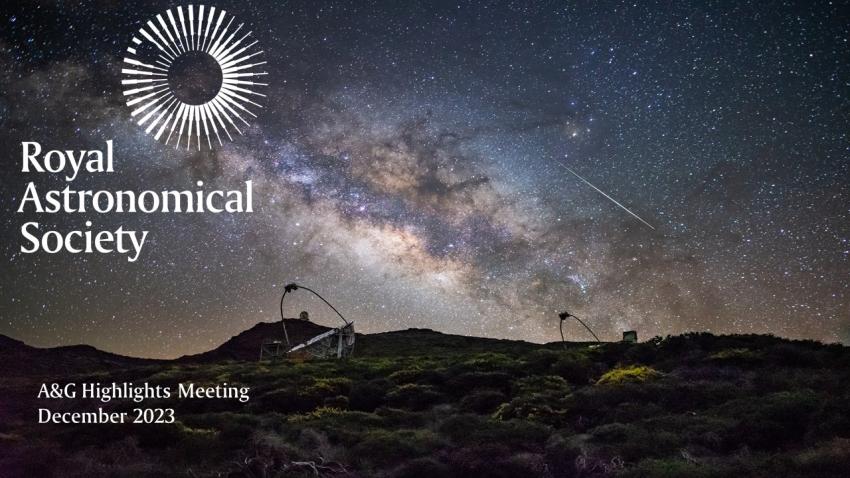Book a RAS A&G Highlights 2023 Online or In Person Ticket
The making of an observatory: the early years of the Cambridge Observatory
Dr Daniel Belteki
RAS Diary Talk
The talk explores the early history of the Cambridge Observatory from its establishment in 1823 to the first few years of George Biddell Airy's directorship. The talk considers the astronomical activity at Cambridge around the time of the Observatory's establishment and the wider role that university observatories played within the field of astronomy. Relying on a recently transcribed journal of George Biddell Airy, it also considers how the practical day-to-day running of the Observatory reflected and conflicted its intended purpose.
Dr Daniel Belteki is a Research Fellow on the Congruence Engine Project at the Science Museum. His work explores the application of digital tools to the history of nineteenth century science, technology, and industry. His previous work focused on the history of astronomy during the nineteenth century, with a specific focus on the history of the Royal Observatory at Greenwich.
MeerKAT
Rob Fender and Ian Heywood (Oxford)
A Group Award
This year the MeerKAT radio telescope celebrates its 5th year of operations, and its receipt of the RAS Group Achievement award for Astronomy. The telescope has revolutionised many aspects of radio astronomy, in particular in the southern hemisphere, and has shown the way to a successful mid-frequency component of the Square Kilometre Array. Amongst many breakthrough observations, the MeerKAT images of the Galactic Centre region revealed for the first time the incredible large-scale radio bubbles around Sgr A*, and the as-yet-unexplained narrow radio filaments in the same region in exquisite details. MeerKAT has also produced major contributions to research in astrophysical transients, extragalactic surveys, pulsar science, and demonstrated commensality in action across its large field of view. As well as the extensive scientific output and technical development, MeerKAT has also supported an intensive program of human capital development in Africa. In this talk we will review the development, scientific highlights and promising future of this ground-breaking array.
Rob Fender is head of Astrophysics at The University of Oxford, and has a long history of working in radio astrophysics, with a focus on astrophysical transients in general and black hole jets in detail. He was awarded the 2020 Herschel medal of the Royal Astronomical Society. Rob is also a visiting Professor at The University of Cape Town.
Ian Heywood is a senior researcher in radio astronomy at Oxford, a visiting Professor at Rhodes University in South African, and an honorary associate of the South African Radio Astronomy Observatory. His work encompasses all aspects of cutting-edge radio interferometry, including developing new and automated ways to process the huge volumes of data that characterise radio astronomy in the 21st century
Are cosmic voids filled with reconnecting magnetic fields from the early universe?
David Hosking
Michael Penston Thesis Prize
It has been suggested that the weak magnetic field hosted by the intergalactic medium (IGM) in cosmic voids might be a relic from the early Universe. If so, the present day strength and coherence length of those fields could be “predicted” from reasonable assumptions about the properties of the primordial field at its genesis, provided that the evolution in the intervening time were understood. Inversely, cosmological models of primordial magnetogenesis could be constrained by precise observations of the fields in voids. In this talk, I shall argue that magnetically dominated turbulent decay — as would have followed magnetogenesis at a phase transition — takes place on the timescale on which the energy-containing magnetic structures reconnect with each other, and conserves the random fluctuation level of magnetic helicity arising in large volumes. These ideas turn out to imply that relics of primordial magnetic fields would be stronger by several orders of magnitude than predicted by previous models. In particular, I shall demonstrate that they imply consistency between the observational constraints on fields in voids and the hypothesis that those fields are relics of a net-non-helical magnetic field generated at the electroweak phase transition.
David Hosking is a Postdoctoral Fellow at the Princeton Center for Theoretical Science (PCTS) and a Research Fellow at Gonville & Caius College, Cambridge. He uses a combination of analytical theory and numerical experiments to study waves, instabilities, and turbulence in astrophysical fluids and plasmas. Dr. Hosking earned his Masters in Mathematical and Theoretical Physics in 2018 and his DPhil in Astrophysics in 2022, both from the University of Oxford. He was awarded the 2022 RAS Michael Penston Prize for his DPhil thesis, which proposed a theory of the decay of magnetohydrodynamic turbulence that combined new statistical invariants with a view of magnetic reconnection as the dominant dynamical process mediating decay. The thesis further analysed the consequences of his theory for the evolution of primordial magnetic fields in the early Universe, finding that any modern-day relics of primordial fields would be several orders of magnitude stronger than had been indicated by previous models.
.


